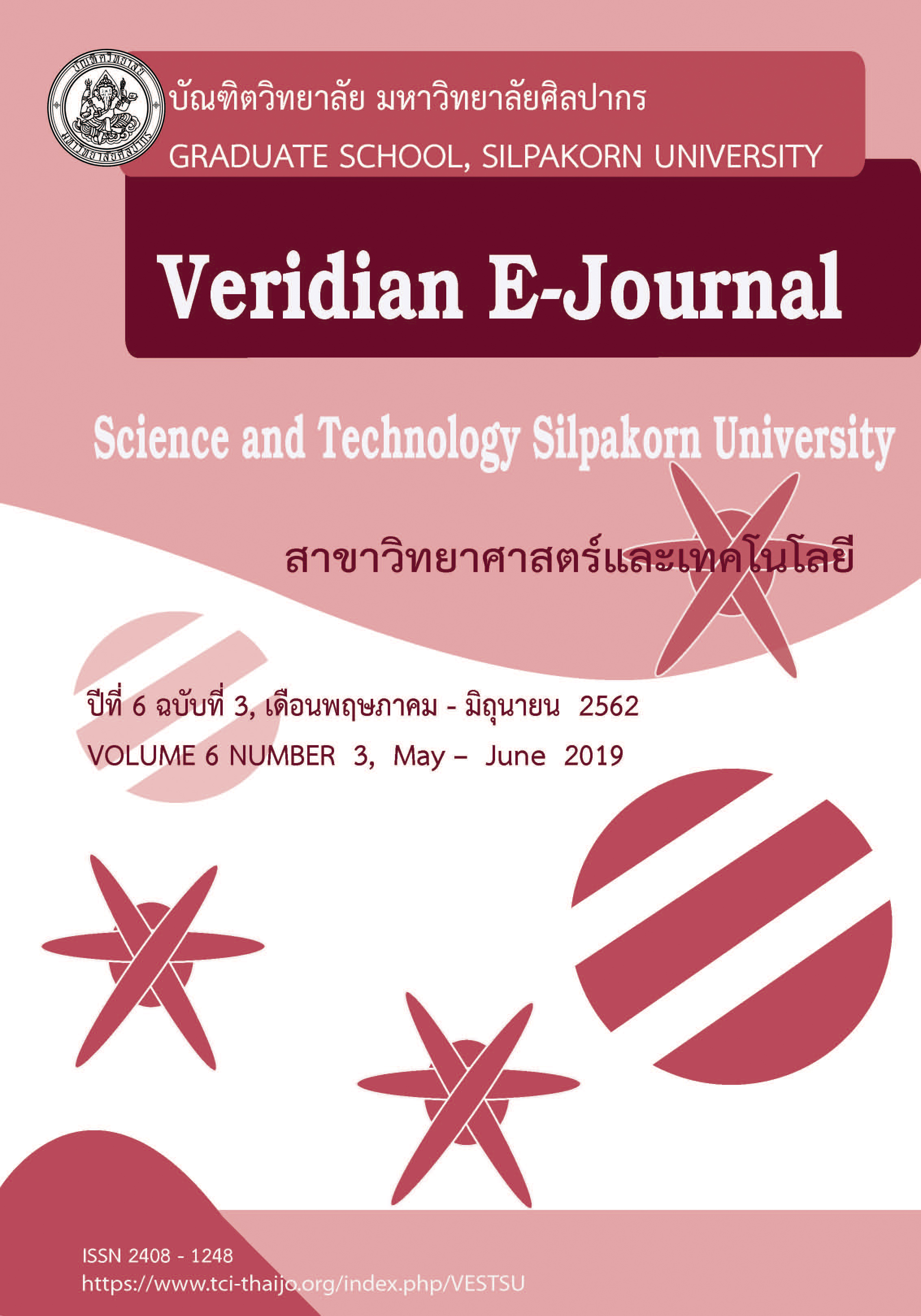การจัดกลุ่มจังหวัดของประเทศไทยตามปัจจัยสภาพอากาศ (Clustering of Provinces in Thailand According to Weather Factors)
Main Article Content
Abstract
การวิจัยนี้เป็นการศึกษาการจัดกลุ่มจังหวัดของประเทศไทยตามปัจจัยสภาพอากาศ ซึ่งมีตัวแปรที่ใช้ในการวิจัยดังนี้ ปริมาณน้ำฝน อุณหภูมิสูงสุด อุณหภูมิต่ำสุด ความชื้นสัมพัทธ์ ความกดอากาศ ความเร็วลม ปริมาณเมฆบนท้องฟ้า และอุณหภูมิตุ้มแห้ง ซึ่งเป็นข้อมูลเฉลี่ยรายปี ตั้งแต่ปี พ.ศ. 2555 ถึงปี พ.ศ. 2560 โดยรวบรวมข้อมูลจากกรมอุตุนิยมวิทยา จากนั้นนำข้อมูลมาวิเคราะห์ โดยวิธีการวิเคราะห์การจัดกลุ่มข้อมูล (Cluster Analysis) โดยใช้เทคนิคการวิเคราะห์กลุ่มแบบเป็นขั้นตอน (Hierarchical Cluster Analysis) ผลการวิเคราะห์ภาพรวมทั้งประเทศ พบว่า ปริมาณน้ำฝนเฉลี่ยรายปีมีแนวโน้มสูงขึ้นในทุกๆปี ส่วนตัวแปรสภาพอากาศอื่นๆ ไม่เปลี่ยนแปลงมากนัก นอกจากนี้ผลการจัดกลุ่มจังหวัดเป็นรายปี ตั้งแต่ปี พ.ศ. 2555 ถึง พ.ศ. 2560 พบว่า จัดได้ 4 - 6 กลุ่ม โดยพิจารณาที่ Dendrogram ที่ระยะห่างเชิงยูคลิดยกกำลังสองเป็น 10 ภาพรวมแล้วพบว่า จังหวัดสมุทรปราการเป็นจังหวัดที่มีสภาพอากาศที่แตกต่างจากกลุ่มอื่นๆ เนื่องจากมีความเร็วลมเฉลี่ยที่สูงอย่างเด่นชัด และมีปริมาณเมฆที่ค่อนข้างสูงแต่กลับมีปริมาณน้ำฝนที่ค่อนข้างน้อยเมื่อเทียบกับจังหวัดส่วนใหญ่ และในปี 2556 เพชรบุรีจะมีสภาพอากาศที่คล้ายกับสมุทรปราการ จังหวัดเพชรบูรณ์เป็นอีกจังหวัดหนึ่งที่มีสภาพอากาศที่แตกต่างจากจังหวัดอื่น โดยเป็นจังหวัดที่มีอุณหภูมิสูงสุดเฉลี่ยรายปีที่สูงที่สุด มีอุณหภูมิต่ำสุดเฉลี่ยรายปีที่ต่ำที่สุดและมีความกดอากาศ ความเร็วลม ปริมาณน้ำฝนเฉลี่ยรายปีที่ค่อนข้างต่ำ จังหวัดฉะเชิงเทราก็มีสภาพอากาศที่แตกต่างจากจังหวัดอื่น โดยมีความกดอากาศรายปีที่สูง มีความชื้นสัมพัทธ์และปริมาณน้ำฝนที่ค่อนข้างสูง มีความเร็วลมเฉลี่ยที่ค่อนข้างต่ำ นอกจากนี้กลุ่มจังหวัดส่วนใหญ่ที่มีสภาพอากาศที่คล้ายคลึงกัน ได้แก่ กลุ่มจังหวัดภาคกลาง ภาคตะวันออกที่ไม่ติดทะเล ภาคเหนือ และภาคตะวันออกเฉียงเหนือ อีกส่วนหนึ่งจะเป็นกลุ่มจังหวัดภาคกลางและภาคตะวันออกที่ติดทะเลโดยอยู่กลุ่มเดียวกันกับจังหวัดบริเวณภาคใต้
This research was clustering of provinces in Thailand according to weather factors. The variables in this research were rainfall, maximum and minimum temperature, relative humidity, air pressure, wind speed, cloud volume in the sky and drying temperature. The data were the annual average of the variables from 2012 to 2017 which were collected by the Meteorological Department. Data were analyzed using cluster analysis with the hierarchical technique. The overall results indicated that the rainfall has an increasing trend every year whereas the other weather factors do not change much. In addition based on dendrogram with the squared Euclidean distance equal to ten, provinces were separated in 4 to 6 groups yearly from 2012 to 2017. The weather factors of Samut Prakan are different from the others because of the obviously high wind speed, cloudy but less rainfall compared to the others. In 2013, Petchaburi had the similar weather factors as Samut Prakan. Phetchabun is another group which has the relatively high maximum temperature, low minimum temperature, air pressure, wind speed, and rainfall. The weather factors of Chachoengsao are also different from other provinces. The air pressure is high, relatively high relative humidity and rainfall and wind speed is low. Moreover, the provinces in North, North Eastern, some part of Central and non-coastal provinces in the Eastern region have the similar weather factors while the provinces in South and coastal provinces in Eastern are in the same group.

